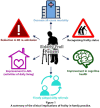Diagnosing Frailty in Primary Care Practice
- PMID: 35464517
- PMCID: PMC9015073
- DOI: 10.7759/cureus.23329
Diagnosing Frailty in Primary Care Practice
Abstract
Frailty is a complex age-related clinical condition with increased vulnerability to negative health outcomes that manifest as a multidimensional syndrome and hence, a challenge to identify at-risk populations. We aim to summarize the implementation of strategies to diagnose fragility in family practice using current evidence. We searched the PubMed and Google Scholar databases for relevant articles, using the Medical Subject Headings (MeSH) terms "Frailty," "Frailty Scales," and "Primary Health Care." All original research articles on the elderly population (65 years of age or older) published in English and the last five years were included. Frailty diagnosis has resulted in positive outcomes in the overall literature. Recent hospital admission may indicate a health problem that can end up in a negative outcome and has been often described as associated with frailty. It was also shown to affect the intensive care units' mortality, in-hospital mortality, and long-term mortality. However, multiple screening instruments have been developed and validated to improve feasibility in clinical practice. The frequent lack of agreement between frailty instruments has slowed the broad implementation of these tools. The impacts of frailty warrant an upstream, proactive, holistic, interprofessional primary care approach to its identification, assessment, and management. It is a preventable disorder; identifying elderly patients at risk in primary care can help shape appropriate care processes tailored to their needs. This literature review aims to demonstrate the importance and strategies in identifying frailty in primary care settings and assess its impact on several outcomes.
Keywords: aging; disability; elderly; family practice; fragility; frailty; geriatric; screening tools.
Copyright © 2022, Somagutta et al.
Conflict of interest statement
The authors have declared that no competing interests exist.
Figures
Similar articles
-
Frailty: Identifying elderly patients at high risk of poor outcomes.Can Fam Physician. 2015 Mar;61(3):227-31. Can Fam Physician. 2015. PMID: 25767167 Free PMC article. Review.
-
Beyond the black stump: rapid reviews of health research issues affecting regional, rural and remote Australia.Med J Aust. 2020 Dec;213 Suppl 11:S3-S32.e1. doi: 10.5694/mja2.50881. Med J Aust. 2020. PMID: 33314144
-
Frailty Screening and Interventions: Considerations for Clinical Practice.Clin Geriatr Med. 2018 Feb;34(1):25-38. doi: 10.1016/j.cger.2017.09.004. Clin Geriatr Med. 2018. PMID: 29129215 Free PMC article. Review.
-
Frailty indexes, screening instruments and their application in Belgian primary care.Acta Clin Belg. 2014 Aug;69(4):233-9. doi: 10.1179/2295333714Y.0000000027. Epub 2014 Apr 29. Acta Clin Belg. 2014. PMID: 24773077 Review.
-
Feasibility and acceptability of commonly used screening instruments to identify frailty among community-dwelling older people: a mixed methods study.BMC Geriatr. 2020 Apr 22;20(1):152. doi: 10.1186/s12877-020-01551-6. BMC Geriatr. 2020. PMID: 32321431 Free PMC article.
Cited by
-
Multiple Myeloma in 2023 Ways: From Trials to Real Life.Curr Oncol. 2023 Nov 3;30(11):9710-9733. doi: 10.3390/curroncol30110705. Curr Oncol. 2023. PMID: 37999125 Free PMC article. Review.
-
Real-World Implementation of PRISMA-7 and Clinical Frailty Scale for Frailty Identification and Integrated Care Activation: A Cross-Sectional Study in Northern Italian Primary Practice.J Clin Med. 2025 May 14;14(10):3431. doi: 10.3390/jcm14103431. J Clin Med. 2025. PMID: 40429424 Free PMC article.
-
To Be Frail or Not to Be Frail: This Is the Question-A Critical Narrative Review of Frailty.J Clin Med. 2024 Jan 26;13(3):721. doi: 10.3390/jcm13030721. J Clin Med. 2024. PMID: 38337415 Free PMC article. Review.
-
Association between Sarcopenia and Poor Glycemic Control in Older Adults with Type 2 Diabetes Mellitus.Diseases. 2023 Nov 30;11(4):175. doi: 10.3390/diseases11040175. Diseases. 2023. PMID: 38131980 Free PMC article.
References
-
- Frailty syndrome in the elderly in elderly with chronic diseases in primary care. Ribeiro IA, Lima LR, Volpe CR, Funghetto SS, Rehem TC, Stival MM. Rev Esc Enferm USP. 2019;53:0. - PubMed
-
- FRAILTOOLS study protocol: a comprehensive validation of frailty assessment tools to screen and diagnose frailty in different clinical and social settings and to provide instruments for integrated care in older adults. Checa-López M, Oviedo-Briones M, Pardo-Gómez A, et al. BMC Geriatr. 2019;19:86. - PMC - PubMed
Publication types
LinkOut - more resources
Full Text Sources

